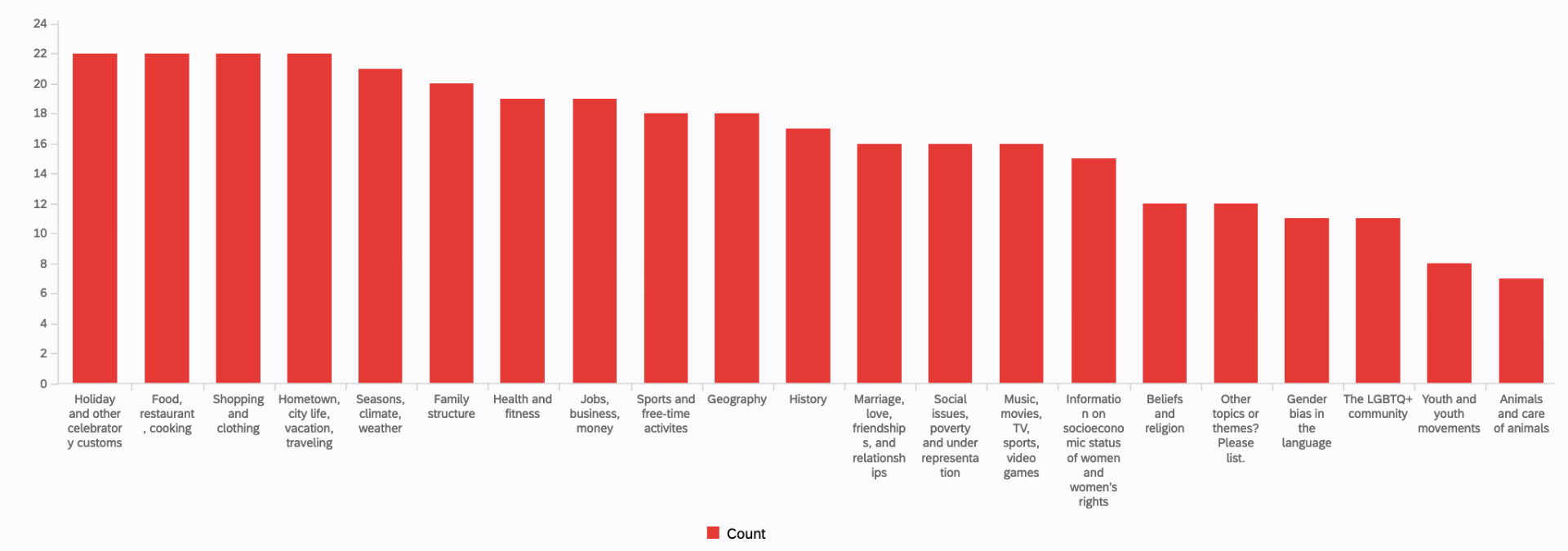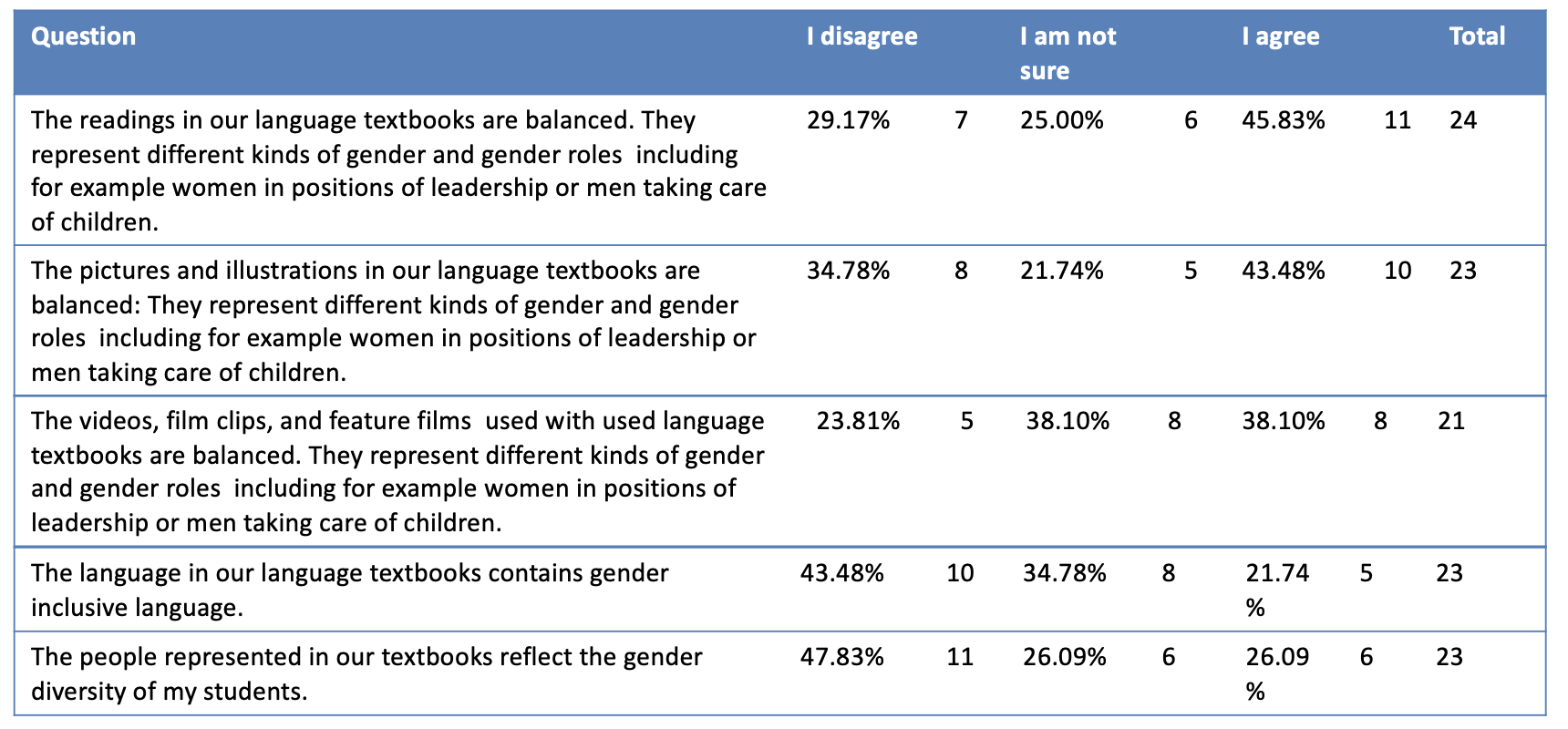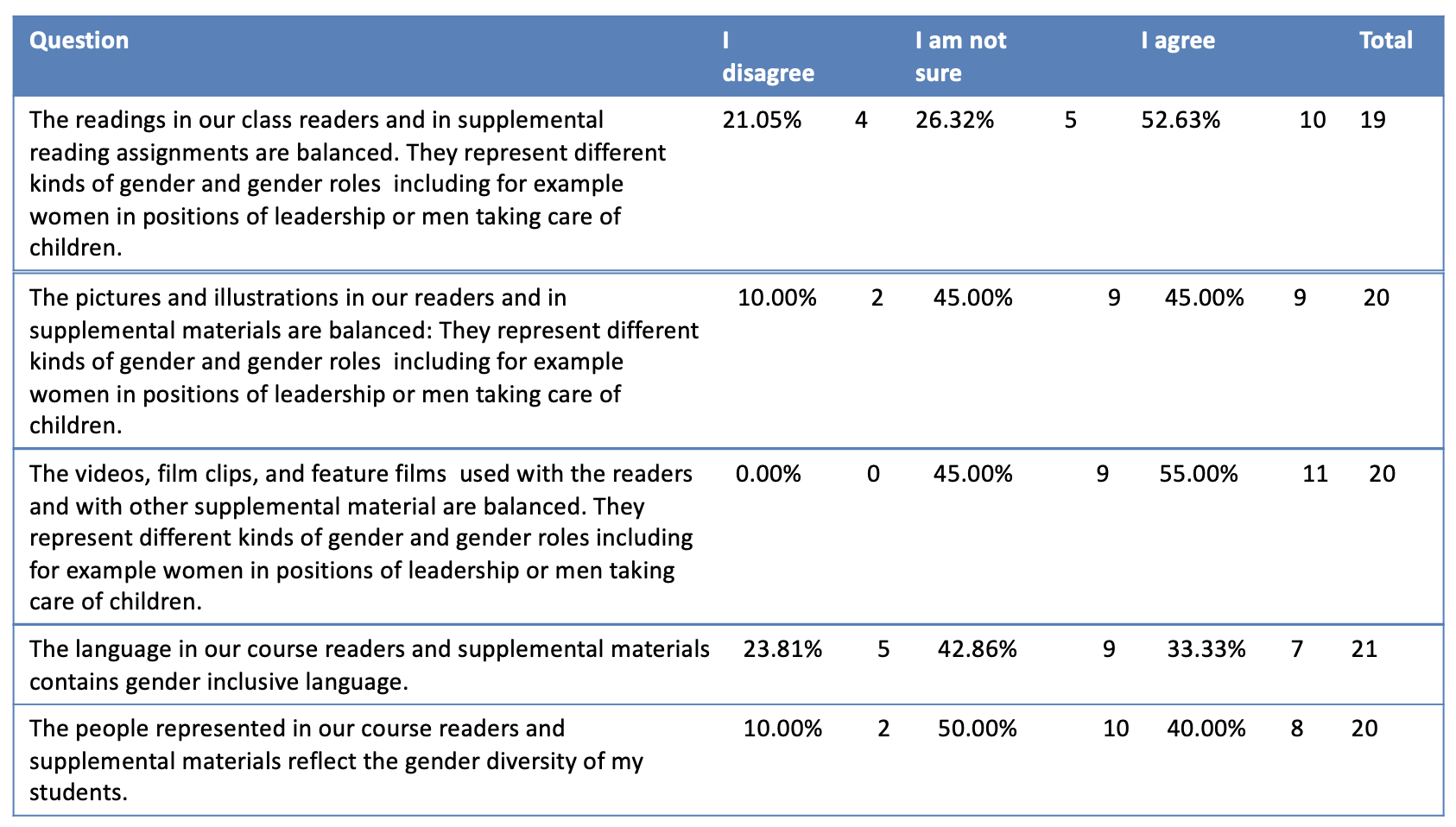What were the goals of this study?
For this study, we distributed a survey in the Spring 2023 to current or former language instructors teaching at Northwestern University. The purpose of the survey was to find out how language instructors perceive their language teaching material (first-year and second-year language textbooks as well as their course readers) as well as classroom dynamics concerning gender and gender equity. Our survey explored the representation of gender in topic choices, the weight given to each topic, and the centrality of various pedagogical choices to evaluate gender bias or gender dominance. We were also interested in learning more about pedagogical approaches in the classroom as well as classroom dynamics. And finally, we wanted to know, what training (pre-service and in-service) instructors had that specifically dealt with gender and gender equity in language teaching and whether they felt they would benefit from additional training.
What was the background of the participants?
The survey was distributed to 72 language instructors teaching a variety of languages at the post-secondary level (Arabic, Chinese, French, German, Latin, Modern Greek, Hebrew, Hindi-Urdu, Italian, Japanese, Korean, Polish, Portuguese, Russian, Spanish, Swahili, Turkish). Of the 27 instructors who finished the survey, 52% identified as White Caucasian, 19% as Asian/Asian American, 13 % as Middle Easter/North African, 6% as LatinX/Hispanic. Two of the participants preferred not to say.

What was the gender of the participants?
As to gender, 74% identified as female. 19% as males. Two of the participants preferred not to say.
Which languages were represented in the study?
The languages represented in the surveys were: German, Chinese, French, Spanish, Polish, Arabic, Portuguese, Hebrew, Turkish, Korean, and Hindu.

What was the teaching experience of the participants?
Most instructors in the survey were experienced instructors: they had taught different proficiency levels (19 instructors taught first-year language classes, 21 instructors taught second-year language classes, 15 instructors taught third-year language classes, and 10 instructors taught fourth-year language classes) and they had several years of teaching experience ( 2 had 1-3 years, 4 had 4-6 years, 4 had 7-9 years, and 16 had more than 9 years)


What were instructors looking for when evaluating a potential language textbook?
We asked survey participants to rank a list of criteria (from most to least important) they might consider when choosing a language textbook. “Range of themes and topics covered”, “soundness of pedagogical approach”, and “grammar topics, explanations, and exercises” were the three most important ones. “Familiarity with publisher”, “familiarity with author”, and “high adoption rate in the United States” were the least important ones.
Which topics are currently being covered in the language class?
When asked about topics or themes currently being covered in the curriculum, the following were selected most often: holiday and other celebratory customs; food, restaurant, cooking; shopping and clothing; hometown, city life, vacation and traveling (selected 22 times) followed by season, climate, weather (selected 21 times); family structure (selected 20 times); health and fitness; and job, business, money (selected 19 times). The LGBTQ+ community, youth and youth movements, animals and care of animals were selected the least often (11, 8, and 7 times respectively).

Which topics would instructors have liked to cover?
The listing of topic was quite different (almost reversed) when asked about topics or themes instructors wished they could cover in the language classroom: Gender bias in the language; the LGBTQ+ cotation; youth and youth movements were listed first. Holiday and other celebratory customs; food, restaurant, cooking; shopping and clothing; hometown, city life, vacation and traveling; season, climate, weather; family structure; health and fitness; job, business, money; sport and free-time activity; history; and geography were listed last, indicating a discrepancy between topics chosen in textbooks and topic that instructors felt were important.

According to instructors, do current language textbooks exhibit gender biases?
Forty-eight percent thought that the readings in their textbooks were balanced (30% disagreed and 22% were not sure); 43% thought that the pictures and illustrations were balanced (22% disagreed and 35 % were not sure); and 40% thought that the videos and film clips were balanced (25% disagreed and 35% were not sure). Forty-five percent disagreed with the statement that their textbook contained gender inclusive language; and 48 % disagreed with the statement that their textbook reflected the gender diversity of their students. The numbers were similar for course readers and additional teaching material. Analyzing the data according to languages represented, instructors of less commonly taught languages evaluated their textbooks and teaching materials less favorably. German and Spanish seemed to have the most balanced teaching material.


Comfort and Concern: Do instructors feel comfortable leading discussions on gender and gender equity?
Instructors felt comfortable leading discussions on gender representation and equity in the language classroom, whether they ever reflected on what students of a different or non-binary gender in class experience, or whether they were concerned that such students were not heard. All instructors indicated that they felt somewhat comfortable or comfortable assigning readings and/or leading discussions on gender representation and equity (22% and 78% respectively). All instructors also indicated that they were concerned about students of a different /non-binary gender and their experience in class (48% said sometimes and 52% said frequently). On the other hand, instructors were not or only sometimes worried about someone with a different gender not being heard (30% said never and 52% said sometimes) or being criticized in class for their believes (39% said never and 52% said sometimes).


Preparedness: Do instructors feel prepared to discuss and address issues of gender and gender equity?
All instructors felt quite prepared to discuss class material about gender, gender representation, and gender equity with their students (43.5% said somewhat prepared and 56.5% said prepared) and all except one felt prepared to address issues of gender inequity in the classroom (43.5% said somewhat prepared and 52% said prepared).

Have instructors received prior pedagogical training that specifically dealt with gender and gender equity?
About 60% of the instructors surveyed had not received prior pedagogical training that specifically dealt with gender and gender equity in language teaching. Although the numbers are small, instructors of less commonly taught languages seem to be less likely to have had specific training. Most of the training that was received came in form of lectures and workshops (nobody mentioned any pre-service training on gender and gender equity) and instructors thought such training was “eye-opening” and “illuminating”.

Would instructors like to receive (additional) training on gender equity in language teaching?
78% percent of those who already had received training indicated that they would like to receive additional training (first graph) and 71% of those who had not received any training indicated that they would like to receive additional training (second graph) on gender equity in language teaching. Very few said they either were not interested in the topic or did not have time.

